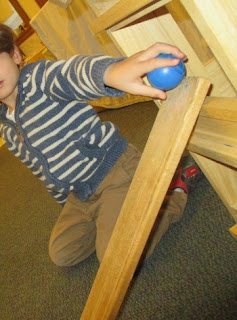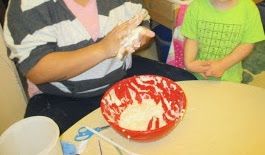Science and math happen all the time during play, but sometimes its fun (or necessary for assessment reasons) to set up an activity and take the time to make note of what the kids know and understand. Ramps are a great option for this, because they are fun, easily accessible, and kids love them!
When I planned with my co-teachers for small group activities, there were two main goals: 1. We wanted the kids to have fun and 2. We wanted the activity to allow us to easily gather the info we needed for whatever assessment we were focusing on. For this activity, our assessment goals were to see whether the children used and understood distance, position and comparison words like close, far, near, farther, closer, higher, lower, faster, slower, etc.
So all we need for this activity are ramps (we had flat boards and some double unit blocks that we used) various things to prop them on at varying heights, balls and other small toys that do and don't roll, a roll of masking tape, and a pen.
We'd break the kids up into pairs (this is a great time to pair up kids who might not normally choose to work together, just to expand their horizons!) and give them all of the materials (other than the pen, which you'll be using). We'd give them a little prep or a challenge, like "Can you guys see which of your toys can roll or slide down your ramp the fastest?" And off they go!
As they work together, using tape to mark where their toys land, you can write the names of the items on those pieces of tape, and encourage them to try things in different ways. "What if you make your ramp lower? Does that make the ball roll faster or slower? Does the block go far from the ramp, or stay close? How can you make your toys move more quickly? Why can't things roll UP the ramp?" Have a notepad or clipboard all set up ahead of time with the kids' names already printed, and jot down notes about what they do and say to transfer to your assessment tool later. You can even use the marked pieces of tape to make a graph with the kids, noting which things traveled farthest from the ramp...





















